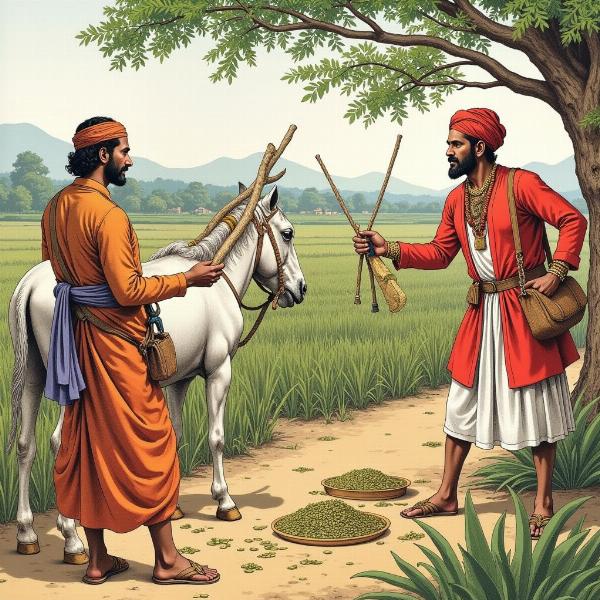Understanding the “manorial meaning in Hindi” often leads us to the historical and cultural context of the Zamindari system. This system, prevalent in India for centuries, significantly shaped the country’s socio-economic landscape. While “manorial” doesn’t have a direct Hindi equivalent capturing its full nuanced meaning, the closest concept relates to the Zamindari system, often referred to as “जमींदारी प्रथा” (Zamindari Pratha). This article explores the core elements of the Zamindari system, its historical evolution, and the implications it had on Indian society.
Understanding the Zamindari System: India’s Historical Land Tenure
The Zamindari system was a land revenue system where the Zamindars, essentially landlords, held vast tracts of land and collected revenue from the farmers cultivating the land. They acted as intermediaries between the ruling power and the peasantry. While the system provided a relatively stable revenue stream for the rulers, it also created a hierarchical social structure, with Zamindars wielding considerable power and influence. This system is often compared to the feudal manorial system of medieval Europe, although significant differences exist.
 Zamindari System in India
Zamindari System in India
“Manorial Meaning in Hindi”: Exploring Related Terms and Concepts
While a direct translation for “manorial” is elusive, several Hindi words capture related aspects of the concept. Terms like “जागीर” (Jagir), “रियासत” (Riyasat), and “मिल्कियत” (Milkiyat) reflect different forms of land ownership and control prevalent in various parts of India. Understanding these terms helps us grasp the complexities of land tenure and administration in the Indian subcontinent. The historical context and regional variations played a crucial role in shaping these different systems.
Evolution of the Zamindari System and its Impact
The Zamindari system evolved over centuries, influenced by various ruling dynasties and administrative policies. From the Mughal era to the British colonial period, the system underwent significant changes, impacting the lives of millions of farmers. The British formalized the system, using it as a primary means of revenue collection. This further solidified the Zamindars’ position and often led to exploitation of the peasantry.
The Abolition of the Zamindari System: A Turning Point
Post-independence India witnessed a significant land reform movement, culminating in the abolition of the Zamindari system. This marked a major shift in land ownership and aimed to empower the farmers. However, the implementation of these reforms faced numerous challenges, and the legacy of the Zamindari system continues to influence land relations in certain regions of India.
Socio-Economic Implications of the Zamindari System
The Zamindari system had far-reaching socio-economic implications, shaping rural India for generations. It created a deeply entrenched social hierarchy, perpetuating inequalities and impacting agricultural practices. The system also influenced social customs, cultural norms, and political power structures.
Conclusion: Understanding “Manorial Meaning in Hindi” Through Context
While “manorial” lacks a precise Hindi equivalent, exploring the Zamindari system provides a comprehensive understanding of its historical and social implications. By examining related terms, its evolution, and its impact, we can grasp the complexities of land ownership and control in India. This exploration provides a contextualized understanding of “manorial meaning in Hindi” and its relevance to Indian history and society.
FAQ:
- What is the closest Hindi equivalent to “manorial”? While there isn’t a direct equivalent, “Zamindari Pratha” (जमींदारी प्रथा) encapsulates many of the core concepts.
- Who were the Zamindars? They were landlords who collected revenue from farmers and held considerable power within their regions.
- When was the Zamindari system abolished in India? It was abolished after India gained independence, with various states implementing the reforms throughout the 1950s and beyond.
- What were the main reasons for abolishing the Zamindari system? The system was considered exploitative and a major obstacle to land reforms and agricultural development.
- What were the long-term consequences of the Zamindari system? The system impacted social structures, economic development, and land relations in India for generations.
- Are there any remnants of the Zamindari system today? While officially abolished, its legacy continues to influence land ownership patterns and social dynamics in certain regions.
- What other terms are related to “manorial” in the Indian context? Terms like “Jagir” (जागीर), “Riyasat” (रियासत), and “Milkiyat” (मिल्कियत) reflect different aspects of land ownership and control.
Meaning-Hindi.in offers expert translation services specializing in various domains, including legal, business, technical, and academic documents. Our team of experienced translators provides accurate and culturally sensitive translations, ensuring your message resonates effectively with your target audience. Whether you need document translation, website localization, or interpretation services, Meaning-Hindi.in delivers high-quality linguistic solutions tailored to your specific needs. Contact us today for a free quote! Email: [email protected], Phone: +91 11-4502-7584. Explore our range of services at Meaning-Hindi.in.